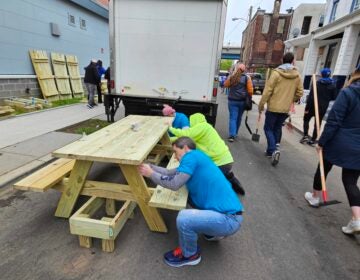Morris Arboretum: A photographer’s walking tour
A photographer sometimes sees the world differently. A great example of this is when Paul Marotta visited Morris Arboretum in Chestnut Hill and brought us back this photographic walking tour. When the NewsWorks website was being built we went through the news archives and pulled out a few gems. I think this is one of them. This essay was originally published on whyy.org in April 2009.
The description on their website states they are “an interdisciplinary center that integrates art, science and the humanities. Thousands of rare and lovely woody plants, including some of Philadelphia’s oldest, rarest, and largest trees, are set in a romantic, 92-acre, Victorian landscape garden of winding paths, streams, flowers and special garden areas.”
It is indeed all that and more, as I discovered early on Saturday morning. Be prepared though, it is an entirely different experience than, say, Longwood Gardens. A quick check in a dictionary will confirm that an arboretum is essentially as the folks at Morris have stated above, but this one has an interesting twist.
I had anticipated that a walk through the arboretum, with the intention of shooting for a photo essay, would be as similar and structured as Longwood, but this was not to be the case. First of all, the site is smaller than Longwood with only 92 acres. And at Longwood the grounds are laid such that you can start at one end, walk the loop and finish up where you started. At Morris Arboretum, though there is a loop one can follow, I was inclined to explore it in an entirely different and unstructured way. And the rewards are many since there are many treasures to be found in out-of-the-way corners and scattered throughout.
Second of all, there are not formal gardens at Morris. In fact as I was trying to organize my thinking and find a way to shoot everything I encountered, I realized that perhaps the best way to shoot was to see things more as sculptures in scattered arrangements than as organized and structured flower beds or flowering trees. It struck me that all the plantings were more sculpted than they were anything else.
To begin with, I was lucky enough to be there on the day that Patrick Doherty’s new installation, The Summer Place, was finished and officially opened to the public. He’s been in residence building it since mid March. The Summer Place is perhaps 30 feet tall, flowing and poetic in nature, and made from materials drawn from the Arboretum itself. It was fun to hear people’s responses to it as they wondered through (“it smells wonderful”) and to see young children running around it and in and out of its cubby holes. You’ll want to pose the family in front of it and take a wide shot, but be sure to look for and at all the detail in it. It has a grace a flow you might never see in sticks and twigs again.
And just beyond it along the little creek that feeds the Wissahickon were, to my surprise, some wonderful and mighty yet very young 90 foot tall redwood trees.
And within this same small area was one of the first permanent sculpture installations I encountered. Inside Out by Buky Schwartz features Stonehenge-like upright blocks of stone. I, however, immediately honed in on some of the detail.
Nearby are situated the greenhouses and Fernery, and again, as a photographer don’t be afraid to look for either the interesting details or unusual compositions that abound here.
Just up the hill nearby is the Rose Garden, obviously too early to be in bloom at this part of the season. But, turn around and look behind you at the beautifully crafted stone walls that are the home of some wonderful flowering cover growing out of its crevices.
Heading back up the hill toward the Visitor Center in my completely unstructured ramble is the gently swaying Two Lines Variable by George Rickey.
Again, do not be afraid to look for unusual angles or ways to shoot the sculptures. For example, you can turn the camera to shoot it from corner to corner as I did.
Moving back down the hill toward the entrance there is much more to see along the way toward the wetland. The Cotswold Sheep by Charles Layland just wanted some unusual angles so I dropped down to the ground with my wide angle 16mm lens pointed toward the deep blue sky.
The Germination Sequence by Linda Cunningham is a terrific piece and you’ll be tempted to shoot it as a group, as I did, but be sure to take a hard look at its beautiful surface textures.
The Wetland was something I felt I could only shoot as a broad expanse as I just didn’t have a long enough lens stuffed into my pockets to capture the abundance of birds which were suddenly agitated and swooping about with my appearance.
Just at the entrance was the Pump House glowing in the early morning sun.
And further along beside the Paper Mill Run creek was some wonderful ground cover of deep green with yellow flowers.
The magnolias are just about bursting so I grabbed a few close-ups of some of their flowers on my way back up and to the Azalea Meadow.
There are some magnificent sculptures here, including John & Lydia Morris by Michael E. Price.
And the terrific sculptures (untitled) by George Sugarman
Again and I can’t stress this enough, be sure to get in close,
look for detail
and unusual angles and juxtapositions.
And speaking of sculpture, the manner in which the massive and beautifully flowering tree is ringed by screaming yellow forsythias is sheer sculpture as well as magnificent color.
I didn’t get to shoot every single piece of sculpture throughout the grounds but there are two more that you will absolutely not want to miss.
One is the blue angular Black Forest by Robinson Fredenthal.
Again by all means shot straight on, but do take a moment to find the interesting play of angles, light and color this piece offers.
And finally, the After B. K. S. lyengar by Robert M. Engman…
…is as deceptive and complicated a work as I’ve seen. It is described on a plaque as three circles intersecting a square. Take the time to walk around it, get inside it and find that unusual play of angles and shapes.
I did all this in about four hours, partly because I took my time shooting and partly because the weather was so nice and there were groups of families and children playing about, singing happy birthday and doing cartwheels on the expansive lawns, and they were a joy to watch, even if they did occasionally get in the way of a shot and force me to wait!
And I couldn’t resist, and who couldn’t, the last shot I grabbed was one of the daffodils in the bed right where I had parked my car!
Paul Marotta was the Executive Director of Public Information for WHYY.
WHYY is your source for fact-based, in-depth journalism and information. As a nonprofit organization, we rely on financial support from readers like you. Please give today.




